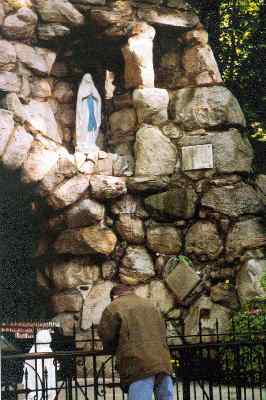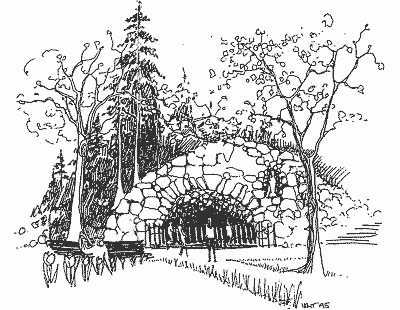
Notre Dame's Grotto / by Dorothy V. Corson


Two Black Stones From Lourdes
In 1958 a special year long celebration of the Centennial of the Lourdes Grotto in France was held on campus. It was celebrated from Lourdes Day, February 11, 1958, through February 11, 1959. An estimated 4000 students attended the celebration. Many ceremonies were held at the Grotto and improvements were made there during that year.
Robert L. Hamilton '34 undertook the paving of the grounds [formerly crushed stone] leading to this favorite shrine of Notre Dame Men.(239)
It is believed that the current "Senior's Last Visit to Sacred Heart and the Grotto" stems from a tradition that evolved during that year long celebration. Father Mike Heppen remembers the seniors' last visit to the Grotto during the month of May when he graduated in 1959. The observance appears to have declined in the 1970s. In early 1981, Father John Fitzgerald, C.S.C., and Steven Warner of Campus Ministry revived the tradition. It has now become "A celebration of four years of friendship in song, readings, and poetry," with sacred music of the Notre Dame Glee Club and Folk Choir, starting at Sacred Heart and ending at the Grotto.
Each year the bulletin announcing the Seniors' Last Visit has been illustrated with a sketch of a campus religious landmark drawn by a graduating senior. This attractive sketch of the Grotto used on the '95 bulletin was done by Kathryn Mapes Turner '95.

Another interesting piece of information about the Grotto was passed on by a Holy Cross Sister from California during a display of the colorful artwork of Sister Paraclita,(240) the only Native American Indian in the Sisters of Holy Cross order. She was visiting the mother house during the summer and was also viewing her work in the convent community room. The subject of the Notre Dame Grotto and all the interesting history associated with it came up in a casual conversation.
"Two black stones from Lourdes are also there," she said. She explained that because they were not easily noticed, it was not common knowledge. Some people knew about them, and some did not, though they may have been familiar with the Grotto for many years. It was something passed on, when someone viewing the Grotto saw the stones being touched or kissed by others and inquired about it. Probably hundreds of people had walked by them, she said, and never knew they were there.
A special trip to the Grotto to locate these two stones produced the same effect. Seeing someone touching them prompted the same curious question. "Is there something special about those stones?"
Who had put them there and when? One was very small, a two inch fragment of stone, which must have been there since it was built. The other stone was black, the size of a Hershey chocolate bar. It looked as if it had been quickly patched in. The cement was much lighter than the rest of the mortar.
The University Archives and the Indiana Province Archives had no photographs of the Grotto picturing the black stones.
Father Edward O'Connor, who conducts the Rosary at the Grotto nightly, said he didn't know about the small one, but he knew the larger black stone was placed there by Father Phillip Schaerf. He was pastor of the Sacred Heart Church from 1957-60, and later head of the Confraternity of Lourdes which dispenses the Lourdes water from France.
He had no idea when he might have placed it there or how it came about, but he was sure there had been no ceremony involved. Either Father Schaerf had cemented it in himself, or with the help of a workman, unbeknown to anyone else.